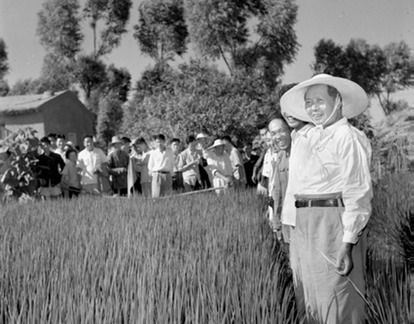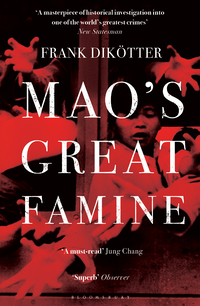Cannibal China, Starved by Mao, Ate Earth, Robbed Graves: Books
When Julie Nixon Eisenhower met Chairman Mao Zedong in Beijing in 1976, she wore a Mao badge -- and thought it fun. More recently, the Archbishop of Canterbury lamented the loss of a China that, under the chairman, had “guaranteed everyone’s welfare.”
After Mao’s Great Famine, Frank Dikotter’s chronicle of how that regime killed at least 45 million people in what he calls the greatest man-made famine the world has seen, no one will have any excuses for modish Maoism.
Dikotter, a professor at the University of Hong Kong on leave from the University of London, has broken through the lies and obfuscation surrounding Mao’s crazed attempt to vault over Soviet Russia and snatch the leadership of the socialist camp by achieving communism at one bound in the Great Leap Forward of 1958 to 1962. His sources -- central and local Communist Party records he nosed out -- are solid, and the result is a shattering book.
Mao’s aim was to “walk on two legs” -- to boost farm production and modernize industry simultaneously. In the countryside, the means were ending private property in favor of forced farm collectives that left peasants gobbling up whatever they had -- animals, grain, seeds -- rather than handing them over. In towns, the result was massive imports of machines that rusted or were broken by famished, comatose workers putting in impossible hours.
Maoist Terror
Such was the efficiency of Maoist terror that no photos of the famine are known to exist, Dikotter says. Yet the facts are enough, and nothing you read will be so harrowing. The inhumanity of man, ideological man especially, scorches every page.
Edema and disease were rife. Party officials beat people to death for stealing grain from fields. They hoarded food for themselves or bartered it for sex. Roads were lined with naked, dying women and children; their last acts were to sell their rags for a mouthful of grain.
Children were sold. Cannibalism was practiced. Burial grounds were dug up and corpses used for fertilizer. People ate leaves, roots, poisonous berries, leather, stolen unripe crops and even the earth itself before succumbing.
Houses were demolished for building materials, and owners herded into collectives -- or left to live wild. Agricultural tools were melted down and “backyard furnaces” established to reach steel quotas. The steel, of course, was useless.
Man-Made Famine
The regime and its Western apologists denied what was happening: It was floods that ruined harvests, they said. But Dikotter shows that it was half-baked schemes designed to humble nature that wrecked drainage and irrigation systems. In the end, even the Communist Party was forced to recognize that the famine was 70 percent man-made. Not so, says Dikotter: 95 percent would be more like it.
Elimination of the profit motive in any guise led to nepotism, viciousness in personal relations and corruption at all levels. Everyone bartered what they had to survive, even as production figures were grotesquely inflated to gratify Mao.
Brave men such as Peng Dehuai, the defense minister, and Vice Party Chairman Liu Shaoqi (who was later eliminated in the Cultural Revolution), protested, but Mao was emperor and his word was law. The conduct of Premier Zhou Enlai -- to this day a darling of the West -- was by contrast cowardly and egotistical. He administrated the disaster, deferring abjectly to his master.
Turning Point
Mao’s famine is not passe history; it’s a turning point of the modern world. The Cultural Revolution was the chairman’s attempt at revenge on his “rightist” colleagues for “sabotaging” his schemes, and it was this second Maoist disaster of 1966 to 1976 that finally impelled China toward capitalism and greater freedoms after his death.
The genesis of today’s China, and of the new world order it is bringing, lies in the merciless actions of one of the bloodiest tyrants -- if not the bloodiest -- of modern times. Dikotter has done a service to history and, when they are allowed to read it, to the Chinese themselves.
And who knows? Maybe even the Archbishop of Canterbury will read it.
Mao’s Great Famine: The History of China’s Most Devastating Catastrophe, 1958-62 is published by Bloomsbury in the U.K. and by Walker in the U.S. (422 pages, 25 pounds, $30). To buy this book in North America, click here.
(George Walden witnessed the Cultural Revolution as a U.K. diplomat in Beijing in 1966-69. A former Member of Parliament, he is the author of “China: A Wolf in the World?” and a critic for Muse, the arts and leisure section of Bloomberg News. The opinions expressed are his own.)
To contact the writer on the story: George Walden in London at gwashch@aol.com.

